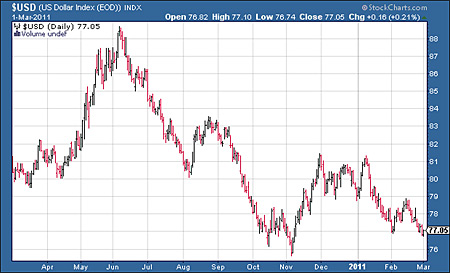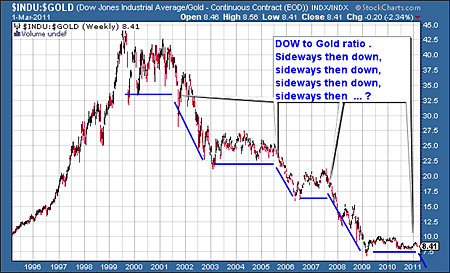Could gold hit $1,500 by the end of May?
The price of gold has hit another new high. And what's significant is that it's now rising independently of other asset classes. Dominic Frisby examines if we really are seeing a de-coupling - and if so, what it means for the gold price, the economy and your investments.
The correction is dead. Long live the bull market.
Another week, another new high in gold and silver.
The inexorable rise continued yesterday with gold breaking out to new all-time highs at $1,433 per ounce. It's now in positive territory for the year. Silver meanwhile hit $34.65 per ounce.
MoneyWeek
Subscribe to MoneyWeek today and get your first six magazine issues absolutely FREE

Sign up to Money Morning
Don't miss the latest investment and personal finances news, market analysis, plus money-saving tips with our free twice-daily newsletter
Don't miss the latest investment and personal finances news, market analysis, plus money-saving tips with our free twice-daily newsletter
But here's the action that surprised me: gold was up in the face of falling stock markets
Has gold 'decoupled' from other assets?
I have been harping on about this all-one-market syndrome for a while. This is where asset prices be they stocks, precious metals, commodities or fine art rise together, as the US dollar falls. Then, when the dollar stages one of its anaemic rallies, asset prices fall.
But in the last three months there has been some possibly significant de-coupling action. Early November 2010 saw gold's first attempt to break through the $1,425 barrier. This failure coincided with highs in the stock markets of India, Russia, China, and others the emerging markets, in other words. They have all been in marked downtrends ever since, although there are signs some sort of low may have been made.
As these markets turned down, so the US dollar rallied or at least, it did at first. But, come December, this rally was overtaken by the major Western stock markets. The Dax, the FTSE, the S&P 500, Dow and Nasdaq all powered on higher, and the US dollar turned down.
Indeed, until a week ago, Western stock markets seemed oblivious to the revolution that is spreading through North Africa and the Middle East like a Mexican wave. It's only now that concerns seem to have finally set in and stock markets are selling off. The Dow was down some 200 points yesterday.
But, unlike in 2008, money is not seeking the 'safety' of the US dollar. The dollar is down on the year, and, yesterday, even with that ugly stock market action, little better than flat on the day.
Here we see the US dollar index, which shows the dollar against a basket of foreign currencies.

Money did, however, seek out gold, which broke out to new highs. Indeed it closed near the high of the day, which usually bodes well.
If gold goes to $1,500, silver could breach $40
Now I think there's a good chance that gold could set off on one of its runs here. I don't know, of course, nobody does. But my magical 144-day moving average (see my previous money morning: Gold will hit $1,650 before the end of the year) (the green line in the chart below) has held; gold is in a nice channel; we have broken out to new highs; and mid-March to the end of May is often a strong time of year for gold.
A move back to the top half of that channel will see us over $1,500 within a month or three.

On the negative side, gold stocks are lagging and are still below their December 2010 highs. But a few more days like yesterday will see them catch up pretty quickly.

Claim your FREE report: The 6-step game-plan for
spread betting profits
If gold stocks are lagging, silver is leading and the action in this market is simply breathtaking. If gold makes it to the $1,500 range, then silver will be somewhere over $40. At present silver is the most expensive it has been relative to gold since 1985, when the silver:gold ratio brokeabove 45.
On current form we are headed back to the old ratios of the 1970s, when silver was considerably more expensive in relative terms. (I will talk at length about the ratio between gold and silver in a future Money Morning). We might even one day see the old monetary ratio of 15-18, which would mean more than a doubling of the silver price even if gold doesn't move.
Soaring gold could be a nightmare for the rest of the economy
But one day doesn't make a market. Are we really seeing a de-coupling? Are we finally entering a period when gold rises just as stocks fall? I don't know. But my friend, the trader Roy Barber, is fond of sending me charts of the ratio between gold and the Dow.
This has been falling since 2000, when the Dow was incredibly expensive against gold. He thinks that ratio is eventually falling back to 1:1. So, if the Dow is at 10,000, so will gold be at $10,000. I'm slightly more conservative than that. But here's my simplification of his stepping-down pattern:

But a rising gold price in the face of falling stock markets over a sustained period? That will mean there is an ugly scenario across the broader economy. Be careful what you wish for
Our recommended article for today
A small-cap stock that could help slash your energy bills
This small-cap engineering firma specialist in technology that could slash household energy bills, has already caught the attention of some big-name tech firms. Tom Bulford looks into the prospects of this promising penny share.
Get the latest financial news, insights and expert analysis from our award-winning MoneyWeek team, to help you understand what really matters when it comes to your finances.
MoneyWeek is written by a team of experienced and award-winning journalists, plus expert columnists. As well as daily digital news and features, MoneyWeek also publishes a weekly magazine, covering investing and personal finance. From share tips, pensions, gold to practical investment tips - we provide a round-up to help you make money and keep it.
-
 'Investors should brace for Trump’s great inflation'
'Investors should brace for Trump’s great inflation'Opinion Donald Trump's actions against Federal Reserve chair Jerome Powell will likely stoke rising prices. Investors should prepare for the worst, says Matthew Lynn
-
 The state of Iran’s economy – and why people are protesting
The state of Iran’s economy – and why people are protestingIran has long been mired in an economic crisis that is part of a wider systemic failure. Do the protests show a way out?

